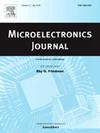一种用于双通道DDR存储系统的谷感模拟峰值电流模式控制降压变换器
IF 1.9
3区 工程技术
Q3 ENGINEERING, ELECTRICAL & ELECTRONIC
引用次数: 0
摘要
这项工作提出了一种谷感模拟峰值电流模式控制降压转换器,专门针对高性能双数据速率同步动态随机存取存储器(DDR SDRAM)应用进行了优化。在这项工作中,设计了一个双通道同步降压转换器,以提供DDR应用所需的低电压。在传统的峰值电流型仿真控制的基础上,提出了一种具有可配置预偏置电流传感的新颖电路结构。这种增强确保电流传感元件免受高压应力的影响,并防止电流传感电路中的次谐波振荡。更重要的是,它可以实现源和汇电流的双向切换,这对于DDR电源解决方案至关重要。实验验证和测试结果表明,该双通道降压变换器的输入电压范围为3.3 V ~ 15 V,最大输出源电流为6 a,峰值下沉电流为3 a。该芯片采用180 nm双极cmos - dmos (BCD)工艺技术制造,最小导通时间为132 ns,最小关断时间为400 ns,工作频率为300 kHz。芯片整体尺寸为2.2 mm × 3.1 mm,核心面积(不包括焊盘)为1.8 mm × 2.7 mm。本文章由计算机程序翻译,如有差异,请以英文原文为准。
A valley-sensed emulated peak current-mode controlled buck converter for dual-channel DDR memory systems
This work presents a valley-sensed emulated peak current-mode controlled buck converter specifically optimized for high-performance double data rate synchronous dynamic random access memory (DDR SDRAM) applications. In this work, a dual-channel synchronous buck converter is designed to provide a low voltage required for DDR applications. Building upon traditional emulated peak current-mode control, an innovative circuit structure with configurable pre-bias current sensing is introduced. This enhancement ensures that current sensing components are protected from high voltage stress and prevents sub-harmonic oscillations in the current sensing circuit. More importantly, it enables bidirectional switching of source and sink currents, which is essential for DDR power supply solutions. Experimental verification and testing results demonstrate that the dual-channel buck converter has an input voltage range of 3.3 V to 15 V, with a maximum output sourcing current of 6 A and a peak sinking current of 3 A. The chip is fabricated using 180 nm Bipolar-CMOS-DMOS (BCD) process technology, featuring a minimum turn-on time of 132 ns, a minimum turn-off time of 400 ns, and an operating frequency of 300 kHz. The overall chip dimensions are 2.2 mm 3.1 mm, while the core area, excluding pads, measures 1.8 mm 2.7 mm.
求助全文
通过发布文献求助,成功后即可免费获取论文全文。
去求助
来源期刊

Microelectronics Journal
工程技术-工程:电子与电气
CiteScore
4.00
自引率
27.30%
发文量
222
审稿时长
43 days
期刊介绍:
Published since 1969, the Microelectronics Journal is an international forum for the dissemination of research and applications of microelectronic systems, circuits, and emerging technologies. Papers published in the Microelectronics Journal have undergone peer review to ensure originality, relevance, and timeliness. The journal thus provides a worldwide, regular, and comprehensive update on microelectronic circuits and systems.
The Microelectronics Journal invites papers describing significant research and applications in all of the areas listed below. Comprehensive review/survey papers covering recent developments will also be considered. The Microelectronics Journal covers circuits and systems. This topic includes but is not limited to: Analog, digital, mixed, and RF circuits and related design methodologies; Logic, architectural, and system level synthesis; Testing, design for testability, built-in self-test; Area, power, and thermal analysis and design; Mixed-domain simulation and design; Embedded systems; Non-von Neumann computing and related technologies and circuits; Design and test of high complexity systems integration; SoC, NoC, SIP, and NIP design and test; 3-D integration design and analysis; Emerging device technologies and circuits, such as FinFETs, SETs, spintronics, SFQ, MTJ, etc.
Application aspects such as signal and image processing including circuits for cryptography, sensors, and actuators including sensor networks, reliability and quality issues, and economic models are also welcome.
 求助内容:
求助内容: 应助结果提醒方式:
应助结果提醒方式:


